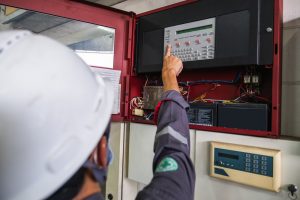 Fire alarms are observed in almost every public building we enter, such as schools, hospitals, shopping malls, grocery stores, hotels, and so on. Data indicates that one of the most effective ways to avoid significant property damage or death during a fire is to have a fire alarm in place.
Fire alarms are observed in almost every public building we enter, such as schools, hospitals, shopping malls, grocery stores, hotels, and so on. Data indicates that one of the most effective ways to avoid significant property damage or death during a fire is to have a fire alarm in place.
Fire alarms are fitted in all buildings in this period of technology. Nevertheless, the bad news is that not all of them are up to code. For this purpose, The National Fire Protection Association (NFPA) has set standards for fire alarm installation to ensure that the alarm systems work properly and safeguard lives as well as property.
What Are The NFPA Standards For Fire Alarm Installation?
The NFPA has outlined standards for the correct implementation of fire alarm systems to promote consistency and quality performance. Here are some of the critical standards that must be followed.
Standard 72
This is the standard design for NFPA fire alarm installation. The design demands that buildings’ alarm systems be made explicitly to the size of the building and the fire hazards it has. Furthermore, equipment should be picked to meet these specifications. This safeguards the building as much as possible and guarantees that any concerns can be quickly resolved.
Standard 72A
This standard covers the voice alarms that are activated by smoke detectors. For public buildings and residential apartments, voice alarms are regarded as excellent practice. Being able to convey necessary information in addition to the general alarm benefits the building’s safety.
Standard 72B
This standard primarily covers various inspections required to maintain the overall safety of the alarm system. It is imperative to recognize that adding an alarm system is only the first move in fire safety – inspections and maintenance are essential for ensuring that it functions adequately.
Standard 72E
This standard is effectively protecting lives. It addresses a host of alarms and warnings for individuals with hearing disabilities, including audio, visual, and vibrational systems.
Standard 72G
Standard 72G recognizes that technology has radically advanced because it was initially established, particularly in the field of sensing technology. As a result, this standard addresses the various kinds of sensors accessible for fire detection, providing a decision-making tool for systems requiring a specific degree of detection capability.
Why Is It Essential To Follow The NFPA Standards For Fire Alarm Installation?
Cost Savings
The primary benefit of adhering to fire alarm installation standards is cost-savings in the long term. This is because the standards guarantee that the right equipment is chosen, and the overall system configuration has been appropriately designed the first time. As a consequence, a correctly installed fire alarm system requires fewer revisions and maintenance, resulting in long-term savings.
Safety
Second, following fire alarm installation standards promotes safety. When a fire alarm system is configured in accordance with the codes, it performs optimally and optimally mitigate the hazards. This enhances the safety of both property and people in the facility.
Legal Compliance
Failure to adhere to fire alarm installation standards can result in legal consequences. In the event of a fire, the absence of a properly configured fire alarm can cause severe harm or even fatalities resulting from a lawsuit against the building owner.
Proper Implementation of Fire Prevention Techniques
Standards help to standardize implementation techniques, ensuring that the proper procedures are followed in the fire alarm installation process. This ensures that any developments or repairs are properly addressed to guarantee the safety of a building’s inhabitants.
Conclusion
Following the NFPA Standards for Fire Alarm Installation brings numerous advantages to both building owners and their tenants. A correctly installed fire alarm system is an essential aspect of fire safety in any building. Fire alarms, coupled with other fire prevention strategies such as sprinkler systems, firefighting equipment, and training on how to respond to a fire, make a complete fire safety solution for any building. Safeguarding the safety of human life and properties requires everyone’s contribution: building owners, management, and tenants should recognize their responsibilities in working together to ensure fire safety and compliance.
Fire alarm standards exist to guarantee our safety during fire outbreaks. Following these standards will improve the likelihood of avoiding fires, detecting them early, and preventing them from spreading. This, in turn, significantly minimizes the potential of damage to property, injuries, and, in the worst-case scenario, fatalities. It is, therefore, a sound choice for building owners to adhere to these standards to safeguard their tenants’ safety and avoid legal woes. And if you want to make sure that you fire alarm system is good to go for if and when disaster strikes, reach out to us today!

